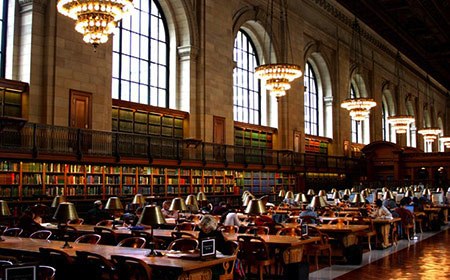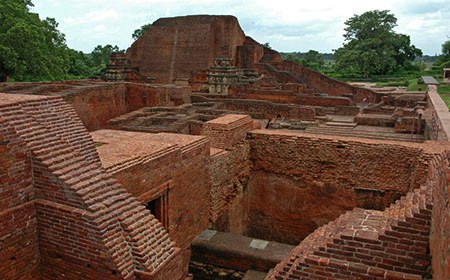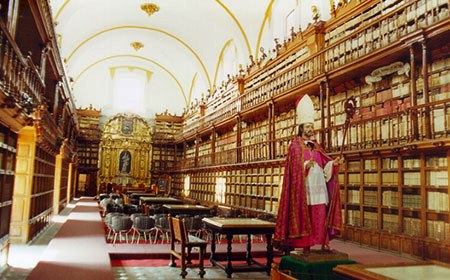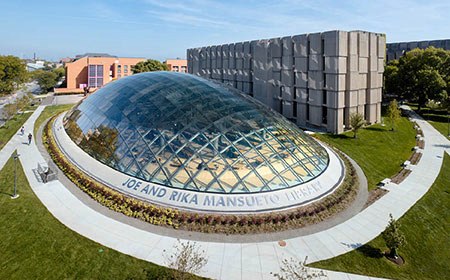A library is a wonderful place, where you can lose yourself in a breathtaking world of science, travel, fiction and more. Here is a walk through some of the best libraries in the world.
It was Harold Edward Holt, Prime Minister of Australia, who said, in 1966, during a stone laying ceremony of a library that, “We cannot understand the present or plan for the future without the knowledge of the past.” How true! This brings us to looking at some of the great libraries of the world.
Scattered across the great continents, they are where some of the world's greatest collections of documents, books and manuscripts lie, to be read, seen and researched. What they have include print, audio, and visual materials, as maps, prints, documents, microform, CDs, cassettes, videotapes, DVDs, video games, e-books, audio-books and other electronic resources.
Yale University Library:
The first in the list is theYale University Library, at New Haven, Connecticut, is a part of the Yale University. It is said to be the second-largest academic library in North America (after Harvard) and has about 13 million volumes. This also makes it “the fifth largest library collection in the U.S.”.
Some of its specialised collections include: the ‘Babylonian Collection,' which has the largest collection of cuneiform inscriptions in the U.S., clay tablets in all sizes and shapes, stamp and cylinder seals, the complete library in the fields of Assyriology (the study of ancient Mesopotamia) and Hittitology, and early manuscripts and rare books in literature, theology, history, and the natural sciences. Another section, called the ‘Divinity Library Special Collections,' has records of Christian missionary activities. Further, there are: the ‘Government Documents and Information Center' (documents from the U.S., Canadian governments, United Nations and the European Union.), the ‘Lewis Walpole Library' (18th Century English books, manuscripts, prints, drawings, watercolours and paintings); the ‘Lillian Goldman Law Library' (rare books on Anglo-American common law materials; the ‘Manuscripts and Archives,' which looks after material on the U.S., Latin America, South Africa, East Asia, the former Soviet Union and the Middle East.); a ‘ Holocaust Testimonies' section; a ‘ world map' collection (from the 15th Century); a ‘Medical Historical Library' (on the history of medicine); a ‘Music Library Special Collection' (early publications of opera scores, chamber music, and works for keyboard and plucked-string instruments); ‘ Historical Sound Recordings,' the very famous ‘Peabody Museum of Natural History'; the ‘Yale Center for British Art'; the ‘Yale University Art Gallery' and the ‘Yale Collection of Musical Instruments.' That is truly a very impressive stock in a library.
The New York Public Library:
Historian David McCullough described the New York Public Library as “one of the five most important libraries in the United States” — others being the Library of Congress, the Boston Public Library, and the university libraries of Harvard and Yale. With over 16 million volumes, it is said to be the third largest public library in the U.S., behind the Library of Congress and the Boston Public Library. It originated in the 19th Century and has a very interesting history. It advertises itself with a one-liner: “In fact, the Library has but one criterion for admission: curiosity.”
It calls itself “one of the great knowledge institutions of the world, with its myriad collections ranking with those of the British Library, the Library of Congress, and the Bibliothèque nationale de France.” The library's 90 locations include four research centres that look at the humanities and social sciences; the performing arts; black history and culture; and business and industry. It stores about 65 million items, which even the visually handicapped can access, and holds exhibitions and programmes. The library's collection of old newspapers includes the New York Atlas. It also has historic children's materials, including the original stuffed animals that inspired the “Winnie-the-Pooh” children's classics.
Russian State Library:
The national library of Russia, located in Moscow,is the largest in the country. It is said to store more than 43 million items including over 17 million books, 13 million journals, 350 thousand music scores and sound records, 150,000 maps, and other items in 247 global languages.
Harvard University Library:
The Harvard University Library system covers more than 70 libraries, with nearly 17 million volumes. It is said to be the oldest library system in the U.S., and the largest academic as well as the largest private library system in the world. Some of its collections form an important part of “Google Books Library Project.”
British Library, London:
It asks readers, visitors and researchers to explore its 14 million books, 9,20,000 journal and newspaper titles, 58 million patents, three million sound recordings, and much more in hundreds of subject areas. It gets a copy of every publication produced in the U.K. and Ireland. Its collection includes over 150 million items, in most known languages, with three million new items added every year, Its sound archive has recordings from 19th-century cylinders, to CD, DVD and MD recordings. It has eight million stamps and other philatelic items. All this is kept on 625 km of shelves! It says that if a visitor reads five items each day, it would take him over 80,000 years to see its entire collection. It also operates the world's largest document delivery service. Its treasures include the Magna Carta, Leonardo da Vinci's notebook and first edition of The Times, from March 18, 1788. In addition it has material over 3,000 years old, that include Chinese oracle bones.
Deutsche Bibliothek:
The German National Library or the Deutsche Nationalbibliothek or just DNB) is the national bibliographic centre for the Federal Republic of Germany. Its task is to collect and document all German and German-language publications from 1913, foreign publications about Germany, translations of German works, and the works of German-speaking emigrants published abroad between 1933 and 1945. It has a major role in the development of international library standards. It also looks at music-related archiving (both printed and recorded materials). Its “Anne-Frank-Shoah-Bibliothek” is its most recent special collection that records the literature published worldwide on the persecution and extermination of the Jews of Europe.
National Library, Canada:
In 2004, the National Archives of Canada and the National Library of Canada were clubbed together to form the Library and Archives Canada.
Here are the facts about it: 20 million books, periodicals, newspapers, microfilms, literary texts and government publications, three million architectural drawings, maps and plans, 24 million photographs, 350,000 hours of film, 4,25,000 pieces of art (paintings, drawings, watercolours, posters, prints, medals and caricatures), 5,47,000 musical items and more than a billion megabytes of digital content. Some of its rich subject areas include genealogy and family history, portrait collection, aboriginal peoples, exploration and settlement, literature, military and peacekeeping, philately and postal history and sports. It has periodicals, microfilms, manuscripts and theses. Added to these are portraits of over one million Canadians since 1689, and a vast collection of medals, seals, posters and coats of arms. In addition, there are over 71,000 hours of short and full-length films, documentaries, silent films and “talkies” (black and white, colour) dating back as far as 1897, and over 2.5 million architectural drawings, plans and maps, some of which date back to the beginning of the 16th century.
National Library of China:
The National Library of China is said to be largest library in Asia, and one of the largest in the world with a collection of over 23 million volumes. It has some of the largest and richest global collections of Chinese literature and historical documents. Its collections are a treasure trove — inscribed tortoise shells and bones, ancient manuscripts, and block-printed volumes, rare documents and records from past dynasties in Chinese history and foreign language material in over 115 languages. It also has copies of Buddhist documents, the most complete surviving documents from the Ming Dynasty and the Qing Dynasty. Most of these libraries have social media links as well. This includes YouTube channels.
The National Diet
Library, Tokyo, Japan:
Its primary role is to collect and preserve Japanese publications. It has two main facilities in Tokyo and Kyoto, and other branch libraries across Japan. Its major sets include historical documents helping to trace the development of Japanese modern politics in and after the latter half of the 19th century; materials on the post-war occupation of Japan, science and technology documents (includes nuclear power reports); parliamentary documents, maps (topographic, geological and hydrographic), sound recordings of phonographic records produced in Japan and foreign books about Japan and Asian language books. There are also the “Ito Bunko” and “The Shirai Bunko” — two collections of manuscripts and wood block-printed books on medicinal herbs, and the “The Shinjo Bunko” (collections of old writings on astronomy and calendars.)
Library of Congress, Washington D.C.:
It wouldn't be wrong to call it the Emperor of Libraries, “the largest library in the world.” The Library of Congress was established by an Act of Congress in 1800 with the seat of power moving from Philadelphia to Washington. The need for a library found mention in this, where it stated it should contain “such books as may be necessary for the use of Congress -- and for putting up a suitable apartment for containing them therein…” In 1814, invading British troops set fire to the Capitol Building, burning the contents of the small library. But President Thomas Jefferson stepped in, offering his personal library as a replacement. As he had spent years accumulating books, “putting by everything which related to America, and indeed whatever was rare and valuable in every science,” his collection was said to be “one of the finest in the U.S.” Congress accepted his generous offer and the library set roots. The Library of Congress building welcomed the world on November 1, 1897, and it was hailed “as a glorious national monument and the largest, the costliest, and the safest library building in the world.” It now has more than 144 million items that include more than 33 million catalogued books and other print materials in 460 languages; more than 63 million manuscripts; the largest rare book collection in North America; and the world's largest collection of legal materials, films, maps, sheet music and sound recordings. It is not without reason that it is called a world resource. It has 21 reading rooms and calls itself “more than a library.” It also focuses on children and teachers. Its annual ‘ National Book Festival' brings together famous authors, storytellers and book-lovers. A Poet Laureate is appointed each year to promote the art of poetry. Teams from the library visit schools across the country to show how its collections can be used in classrooms and enrich teaching and learning. It also says that it has commissioned hundreds of original musical works
By: MURALI N. KRISHNASWAMY
.
 America’s second largest public library (and largest public library system) has received enough grants from the likes of Andrew Carnegie over the years, it simultaneously takes on a museum role; how many others of its ilk can boast ownership of a Gutenberg Bible? Since its 1895 inception, all branches, no matter their focus, have strived to reach out to local communities and promote history (particularly of largely marginalized demographics), science, art, literature, and plenty more.
America’s second largest public library (and largest public library system) has received enough grants from the likes of Andrew Carnegie over the years, it simultaneously takes on a museum role; how many others of its ilk can boast ownership of a Gutenberg Bible? Since its 1895 inception, all branches, no matter their focus, have strived to reach out to local communities and promote history (particularly of largely marginalized demographics), science, art, literature, and plenty more.





